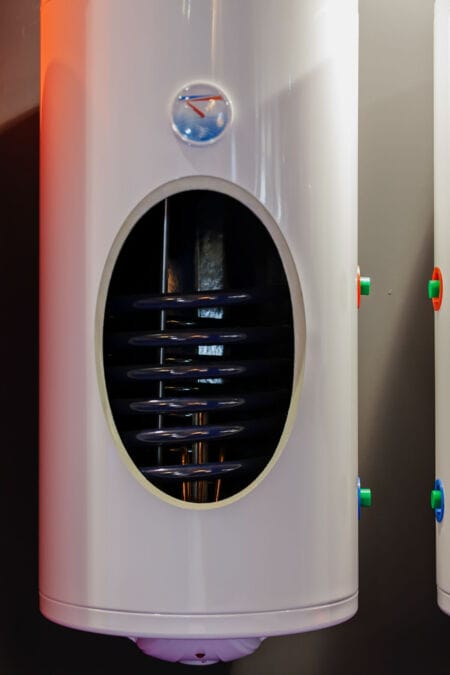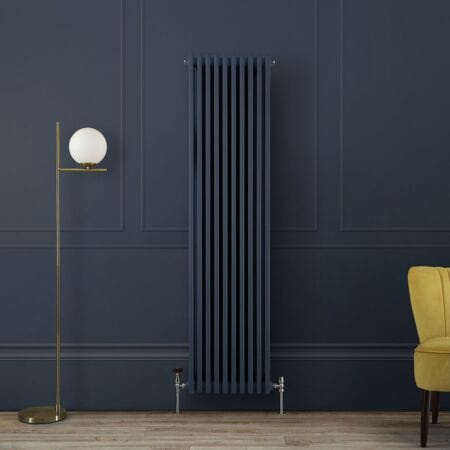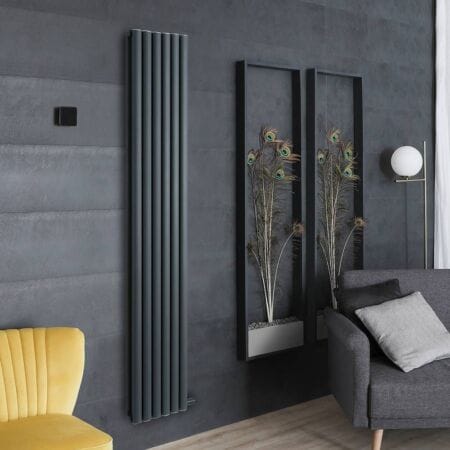Table of Contents
Contents
ToggleWhat we'll cover...
A comparison of the difference between vented and unvented cylinders, outlining the ideal setup for specific homes and layouts. Vented vs unvented cylinders: Which will you choose?
What type of hot water cylinder do I need?
Hot water cylinders aren’t exactly dinner party conversation material (unless your dinner parties are very niche), but they are a crucial part of many home heating systems. Vented systems are typically easier to install and work on a gravity-fed basis, while unvented cylinders can be more expensive and require extra maintenance, but will deliver a higher level of water pressure. Especially pertinent if you like a hot shower that doesn’t transform from power shower to tiny trickle halfway through washing your hair.
In this guide, we’re demystifying the great hot water showdown: vented vs unvented cylinders. We’ll explain what each type is, how they work, and the pros and cons of both systems to help you make the right decision specific to your home.
What is a hot water cylinder?
A hot water cylinder is a tank used for the storage and heating of hot water for your home, for everything from morning showers to washing up last night’s lasagne tray.
It’s an alternative to the instant heating that a combi boiler would provide. And depending on how your system is set up, that cylinder could either be vented (gravity-fed with a cold water tank in the loft) or unvented (pressurised and fed directly from the mains).
Your choice will make a difference to water pressure, installation, and how many family members are able to enjoy the shower before someone ends up with some unwanted cold water therapy.

Understanding vented cylinders
Vented cylinders are the OG hot water tanks. They’ve been around for decades and work by feeding water from a cold water tank (usually located in a loft or attic space) down into the cylinder via gravity. The higher the water tank, the greater the pressure.
The system is ‘open’ to atmospheric pressure, which is where the term ‘vented’ comes from. As water heats and expands, any excess is safely vented back into the cold tank. You can still access the water in this tank even if the mains water supply is cut off for any reason, as well.
However, a compromise is necessary between water pressure and energy efficiency for certain rooms in the home. Given that the height of the water tank plays a part in the pressure it provides, the proximity to upstairs showers and taps will mean a more efficient but less powerful delivery. Contrastingly, unvented cylinders will deliver higher water pressure to downstairs components, but work harder in travelling quite a distance to do so, resulting in a less efficient performance.
Advantages of vented cylinders
- Simple setup: Basic, but reliable. There are fewer moving parts, meaning less can go wrong.
- Cheaper installation: No need for complex heating valves or pressure-balancing gear.
- Good for low-pressure areas: In homes with a weak mains pressure gauge, gravity might still win.
Disadvantages of vented cylinders
- Pressure problems: Water pressure is reliant on gravity, so it can often prove weaker, particularly upstairs.
- Takes up space: You need adequate room for the loft tank and the cylinder.
- Older technology: Less common in new-build properties or housing upgrades.

Understanding unvented cylinders
Unvented cylinders connect directly to your mains water supply. No loft tank is required. Instead, they use expansion vessels and safety valves to cope with fluctuations in pressure. Their incoming water is heated by immersion heaters directly in direct unvented systems, or by an alternative heat source like a wet solar system or boiler in indirect setups.
Once an outlet, such as a tap or shower, is used, the incoming cold water pressure will dislodge the cylinder’s hot water content towards the open outlet at mains pressure. An unvented system is sealed, meaning an expansion vessel is needed to sit beside or be incorporated within the cylinder. This enables the expansion of water in the system as it heats up, and allows for a pressure increase of up to 4.5%.
This setup delivers mains-pressure hot water throughout the house, so you’re more likely to get a power shower than a whimpering dribble.
Can I use an unvented cylinder in a vented system?
Technically not. Unvented cylinders require specific safety features (such as pressure relief valves and expansion control) and are a component of a pressurised sealed system.
That means:
- You can’t simply swap a vented tank for an unvented one without making changes to the heating pipework and boiler.
- You’ll need a qualified heating engineer to assess and convert your setup properly.
Advantages of unvented cylinders
- High pressure: Great water flow for the likes of showers, baths, and taps all at once.
- Saves space: No need for a loft tank.
- Modern design: Preferred setup for new build homes and contemporary renovations or extensions.
Disadvantages of unvented cylinders
- Installation cost: More expensive to fit due to extra safety features such as expansion vessels. Boilerguide suggest an unvented cylinder installation can typically cost anywhere between £300-£1500, but some higher end fittings could comfortably exceed £2000. The size and capacity of the tank can influence outlay too.
- Requires good mains pressure: Not ideal if your mains supply is weak.
- Annual servicing: You’ll need to maintain it properly with an annual service (no cowboy plumbing jobs here).

Vented vs unvented cylinders: Side-by-side comparison
|
Feature |
Vented Cylinder |
Unvented Cylinder |
|
Water source |
Cold water tank (gravity-fed) |
Mains water supply |
|
Pressure |
Lower, gravity-reliant |
High, consistent mains pressure |
|
Space requirements |
Needs loft tank and cylinder |
Just the cylinder (no loft tank) |
|
Installation cost |
Cheaper |
More expensive |
|
Maintenance |
Basic |
Needs annual check |
|
Ideal for |
Older homes with loft space |
Modern homes with good mains pressure |
How to choose the right hot water cylinder for your home
So, how do you select the ideal hot water cylinder based on your home’s quirks and needs?
Water pressure
- Low mains pressure? Homes with low mains water pressure – generally considered to be anything below 0.3 bar, 4.35 PSI, or 10 litres per minute – can stick with a vented system.
- Strong mains pressure? In a house with strong mains water pressure – anything above 1.0 bar, 14.5 PSI, or 15 litres a minute – will be most conducive for operation with an unvented system.
- Average mains pressure? For a household with an average mains water pressure supply – anywhere between 0.3 to 1.0 bar, 4.35 to 14.5 PSI, or 10 to 15 litres per minute – either system could cope with the demand, but an unvented cylinder would be the call for best performance and longevity.
Tip: Ask a plumber to perform a mains pressure check before switching. We all know one (that hopefully owes you a favour).
Space
- Got loft space to spare? A vented system is a viable option.
- Limited space or no loft? Unvented wins with no requirement for a loft tank.
Budget
- Tighter budget? Vented cylinders are more affordable to install. HaMuch estimate the most straightforward of vented cylinder fittings can start at £300, with higher labour costs associated with more complex installations involving pipework etc. Of course, costs can vary based on household location as well. The purchase price of vented cylinders is also lower, ranging from £250 up to the £600 region.
- Long-term investment? Unvented cylinders may offer a better, more durable performance and resale appeal, but are pricier to install from the outset. The same source recommend setting aside between £450 to £2500 depending on the intricacy of the job, benchmarking a £1050 average fee for the most basic supply and fit replacement work. A cost of £3000 is estimated for a fresh heating system installation featuring an unvented cylinder, meanwhile.
Household size
- Big family? Unvented is better at maintaining pressure when multiple outlets are in use, such as radiators, shower system, kitchen tap and any other hot water outlets. Stick with this setup if you live in a busy family home with many people to please (or offer a toasty warm shower to).
- Smaller household? A vented setup is likely to be perfectly sufficient for a household with a smaller family, or with a lower demand for water in general.

Explore BestHeating advice when upgrading water heating setups
Whether you’re in the process of renovation work, or just fed up with the ‘shower pressure shuffle’, choosing the right hot water cylinder can make a world of difference to your comfort and home heating efficiency.
At BestHeating, we help you make smart heating choices for your home, with expert heating advice, and quality products spanning designer radiators to heated towel rails and much more.
Let us know which side of the vented and unvented cylinder argument you land on, and tell us all about your home heating upgrades in the comments, or by reaching out to us on Instagram, Facebook or X.
John is a Research Specialist for the Best Heating Advice Centre, where for over nine years he has dedicated himself to demystifying home heating for our customers. He specialises in creating clear, data-driven guides and how-to articles by collaborating directly with our team of certified heating experts and product engineers.
His work, built on a foundation of journalistic research, has helped millions of readers make confident and informed decisions about their home heating. When he’s not breaking down the heat output differentials from radiators to heated towel rails, John fancies himself as a fine football and music connoisseur.




